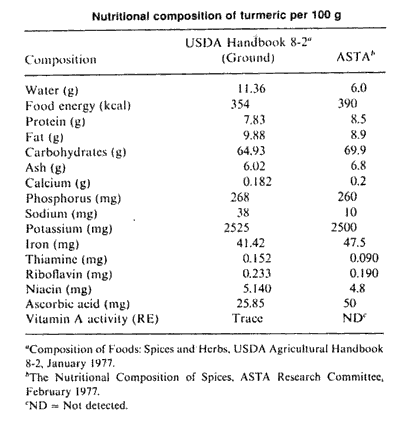Health Benefits of Turmeric
Health Benefits of Turmeric
Introduction
 Turmeric (Curcuma longa) is a flowering plant of the ginger family, Zingiberaceae, the roots of which are used in cooking.
Turmeric (Curcuma longa) is a flowering plant of the ginger family, Zingiberaceae, the roots of which are used in cooking.
The greatest diversity of Curcuma species by number alone is in India, at around 40 to 45 species. Thailand has a comparable 30 to 40 species. Other countries in tropical Asia also have numerous wild species of Curcuma.
The plant is a perennial, rhizomatous, herbaceous plant native to the Indian subcontinent and Southeast Asia. It requires temperatures between 20 and 30 °C (68 and 86 °F) and a considerable amount of annual rainfall to thrive. Plants are gathered each year for their rhizomes, some for propagation in the following season and some for consumption.
The rhizomes are used fresh or boiled in water and dried, after which they are ground into a deep orange-yellow powder commonly used as a colouring and flavouring agent in many Asian cuisines, especially for curries, as well as for dyeing. Turmeric powder has a warm, bitter, black pepper-like flavour and earthy, mustard-like aroma.
History
Turmeric has been used in Asia for thousands of years and is a major part of Ayurveda, Siddha medicine, traditional Chinese medicine, Unani, and the animistic rituals of peoples. It was first used as a dye, and then later for its supposed properties in medicine. From India, it spread to Southeast Asia and with Hinduism and Buddhism, as the yellow dye is used to colour the robes of monks and priests. Turmeric also spread westwards, where it was noted as a dye plant by the Assyrians in the 6th century BC. In Medieval Europe, turmeric was called "Indian saffron".
In Eastern India, the plant is used as one of the nine components of navapatrika along with young plantain or banana plant, taro leaves, barley (jayanti), wood apple (bilva), pomegranate (darimba), Saraca indica, manaka (Arum), or manakochu, and rice paddy.
Turmeric - Traditional Uses
In folk medicine, turmeric has been used in therapeutic preparations over the centuries in different parts of the world.
In Ayurvedic practices, turmeric is thought to have many medicinal properties including strengthening the overall energy of the body, relieving gas, dispelling worms, improving digestion, regulating menstruation, dissolving gallstones, and relieving arthritis.
Many South Asian countries use it as an antiseptic for cuts, burns, and bruises, and as an antibacterial agent.
Indians use turmeric, in addition to its Ayurvedic applications, to purify blood and remedy skin conditions. Turmeric paste is used by women in some parts of India to remove superfluous hair. Turmeric paste is applied to the skin of the bride and groom before marriage in parts of India, where it is believed to make the skin glow and keep harmful bacteria away from the body. Turmeric is currently used in the formulation of several sunscreens. Several face creams are also available which are based on turmeric.
In Ayurvedic medicine, turmeric is a well-documented treatment for various respiratory conditions (e.g., asthma, bronchial hyperactivity, and allergy), as well as for liver disorders, anorexia, rheumatism, diabetic wounds, runny nose, cough, and sinusitis (Araujo and Leon 2001). In traditional Chinese medicine, it is used to treat diseases associated with abdominal pain (Aggarwal, Ichikawa, and Garodia 2004). From ancient times, as prescribed by Ayurveda, turmeric has been used to treat sprains and swelling (Araujo and Leon 2001). In both Ayurvedic and traditional Chinese medicine, turmeric is considered a bitter digestive and a carminative.
Unani practitioners also use turmeric to expel phlegm or kapha, as well as to open blood vessels in order to improve blood circulation. It can be incorporated into foods, including rice and bean dishes, to improve digestion and reduce gas and bloating. It is a cholagogue, stimulating bile production in the liver and encouraging excretion of bile via the gallbladder, which improves the body’s ability to digest fats. Sometimes, turmeric mixed with milk or water is taken to treat intestinal disorders as well as colds and sore throats.
Medicinal properties
Thermogenic, emollient, anodyne, anti inflammatory, vulnerary, depurative, antiseptic, appetizer, carminative, expectorant, stomachic, anthelmintic, stimulant, ophthalmic, tonic, used in skin diseases, dyspepsia, asthma, cough, bronchitis, inflammations, ulcers, worms, skin discolouration
Health benefits
- Taking curcumin, a chemical found in turmeric, seems to reduce hay fever symptoms such as sneezing, itching, runny nose, and congestion.
- Most available research shows that taking curcumin, a chemical found in turmeric, reduces depression symptoms in people already using an antidepressant.
- Turmeric seems to lower levels of blood fats called triglycerides.
- Research shows that taking turmeric extract reduces markers of liver injury in people who have a liver disease not caused by alcohol. It also seems to help prevent the build-up of more fat in the liver in people with this condition.
- Some research shows that taking turmeric extracts, alone or in combination with other herbal ingredients, can reduce pain and improve function in people with knee osteoarthritis.
- Turmeric is also found to help reduce itching in people with long-term kidney disease.
Note: - in current market Turmeric is available in the form of Powder, Raw Turmeric, Golden Milk, Cream
References
- Wikipedia, NCBI, Spices Board of India, Webmd.com, Divya Pharma, Google search & self-study
Written By: - Mr Roshan Vasantrao Pawar | Student - Indira Gandhi National Open University Delhi, School of Social Work
Last Modified : 7/26/2023
This topic covers information about Career in Heal...
The topic covers various aspects of Ayurveda - bas...
This topic provides information about National Cli...
Provides information about the health benefits of ...
